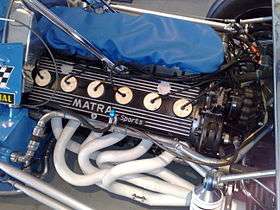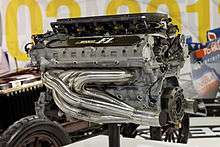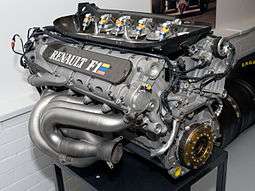List of Formula One engine manufacturers from France
Nine Formula One engine manufacturers from France produced engines either for their own cars or other Formula One chassis manufacturers. Bugatti, Gordini, Matra, Peugeot, Renault and Talbot have designed and produced engines. Mecachrome and Supertec were subcontractors of Renault. CTA-Arsenal competed in only two races before the inception of the World Drivers' Championship in 1950. The Japanese company Asiatech developed and maintained Peugeot engines for two seasons.
Renault engines are associated with 12 of the World Constructors' Championship titles and 11 World Drivers' Championship titles.
All engine manufacturers have followed the regulations of Formula One enacted by the International Automobile Federation (FIA).
Alphabetical list of French Formula One engine manufacturers
Bugatti
The French car manufacturer Bugatti, which competed in Grand Prix racing before the Second World War, created a Formula One engine for its Bugatti T251. It took part in only one race, in 1956.[1]
- T2.5 L8 (1956): inline eight cylinders, 2 .5 L, 230 hp at 8 000 rpm. Designed by Gioacchino Colombo.
Bugatti was based in Molsheim (Bas-Rhin).
CTA-Arsenal
CTA designed an engine for its racing car in 1946. However, it only competed in two races, in 1947 and 1949. The project was abandoned before the creation of the Drivers' World Championship in 1950.[2]
- V8, surcharged, 1.5 L, 215 hp at 6 000 rpm (1946 release) and 275 hp at 8 000 rpm (1948 release). Designed by Albert Lory.
The engines were manufactured in Châtillon-sous-Bagneux (now Hauts de Seine department).
Gordini
Amédée Gordini has designed several engines for French automobile manufacturer Simca and for Gordini Formula One racing cars. Simca took part in 14 Grands Prix from 1951 to 1953 and Gordini 33 from 1952 to 1956.[3]
- T15C (1950) : inline four cylinders, supercharged, 1.5 L, 195 hp at 6 500 rpm.
- T20 (1952) : inline six cylinders, 2.0L, 160 hp at 7000 rpm.
- T23 (1954) : inline six cylinders, 2.5 L, 228 hp at 6 500 rpm.
- T25 (1955) : inline eight cylinders, 2.5 L, 260 hp at 7 500 rpm.
Gordini was based in Paris.
Matra

The Matra engines, V12, 3.0 L, supplied Formula One Matra from 1968 to 1972, Shadow in 1975, and Ligier from 1976 to 1978, in 1981 and 1982.,[4] designed by Georges Martin.
- MS09 (1968) : 395 hp at 10 500 rpm.
- MS12 (1970) : 485 hp at 11 400 rpm.
- MS71 (1971) : 440 hp at 11 000 rpm.
- MS72 (1972) : 485 hp at 11 800 rpm.
- MS73 (1975) : 490 hp at 11 500 rpm. .
- MS76 (1977), MS78 (1978) et MS81 (1981): 520 hp at 12 300 rpm.
Matra Sports F1 was based in the center of France, in Romorantin-Lantenay (Loir-et-Cher).
Mecachrome
Mecachrome manufactured engines designed by Renault (RS9) from 1998 to 2000. They were rebadged as Playlife for Benetton, and rebadged as Supertec for Williams and BAR.[5]
- GC3701-RS09 (1998): V10, 3.0 L, 775 hp at 15 600 rpm.
Mecachrome was based in the center of France, in Aubigny (Cher).
Peugeot

The Peugeot V10 engines supplied several Formula One teams, McLaren in 1994, Jordan from 1995 to 1997, and Prost from 1998 to 2000.[6]
- A4 (1994) : 3.5 L, 700 hp at 14 250 rpm.
- A6 (1994) : 3.5 L, 760 hp at 14 500 rpm.
- A10 (1995) : 3.0 L, 760 hp at 15 500 rpm.
- A12 (1996) : 3.0 L, 720 hp at 15 500 rpm.
- A14 (1997) : 3.0 L, 750 hp at 15 500 rpm.
- A16 (1998) : 3.0 L, 765 hp at 15 200 rpm.
- A18 (1999) : 3.0 L, 785 hp at 15 700 rpm.
- A20 (2000) : 3.0 L, 800 hp at 16 200 rpm.
The Japanese company Asiatech (Asia Motor Technologies France SA), founded by Hideo Morita, near Paris, in Vélizy-Villacoublay, ensured the development of the Peugeot A20 engine. These engines were badged as "Asiatech" and used in 2001 by Arrows, and in 2002 by Minardi during 33 Grands Prix.
Peugeot Sport F1 was based near Paris, in Vélizy-Villacoublay (Yvelines)
Renault

Renault engines equipped Renault Formula One racing cars from 1977 to 1985, from 2002 to 2011, and 2016–present; they have also supplied other teams:[7]
- Team Lotus from 1983 to 1986,
- Équipe Ligier from 1984 to 1986, in 1990, from 1992 to 1994,
- Tyrrell Racing in 1985 and 1986,
- Williams Grand Prix Engineering from 1990 to 1997, in 2012 and 2013,
- Benetton Formula from 1995 to 1997, in 2001,
- Red Bull Racing from 2007 to 2015; from 2016, Red Bull Racing uses Renault engines rebadged as "TAG Heuer"
- Caterham F1 from 2011 to 2014,
- Lotus F1 from 2012 to 2014,
- Scuderia Toro Rosso in 2014 and 2015; from 2017, Scuderia Toro Rosso uses Renault engines rebadged as "Toro Rosso"
Renault Sport F1 is based near Paris, in Viry-Chatillon (Essonne).[8]
V6 1.5 L turbocharged engines
The engine power exceeded 500 hp in the first year of competition.
- EF1 (from 1977 to 1983) : from 510 hp at 11 000 rpm to 650 hp at 12 000 rpm.
- EF4 (1984) : 750 hp at 11 500 rpm.
- EF4-B (1984) : 760 hp at 11 500 rpm.
- EF15 (1985) : 810 hp at 11 500 rpm.
- EF15B (1986) : 800 hp at 12 500 rpm.
V10 engines naturally aspirated


The engine power exceeded 650 hp in the first year of competition (V10, 67°, 3.5 L).
- RS1 (1989) : 650 hp.
- RS2 (1990) : 660 hp at 12 800 rpm.
- RS3 (1991) : 700 hp at 12 500 rpm.
- RS4 (1992) : 750 hp at 13 000 rpm, Nigel Mansell wins World Drivers' Championship, Williams-Renault wins World Constructors' Championship
- RS5 (1993) : 780 hp at 13 800 rpm, Alain Prost wins World Drivers' Championship, Williams-Renault wins World Constructors' Championship
- RS6 (1994) : 790 hp at 14 300 rpm, Williams-Renault wins World Constructors' Championship
The engine power exceed 750 hp in the first year of competition (V10, 3.0 L).
- RS7 (1995) : 67°, 750 hp at 14 300 rpm, Michael Schumacher wins World Drivers' Championship, Benetton-Renault wins World Constructors' Championship
- RS8 (1996) : 67°, 750 hp at 14 500 rpm, Damon Hill wins World Drivers' Championship, Williams-Renault wins World Constructors' Championship
- RS9 (1997) : 71°, 755 hp at 14 600 rpm, Jacques Villeneuve wins World Drivers' Championship, Williams-Renault wins World Constructors' Championship
- RS21 (2001) : 112°, 780 hp at 17 400 rpm.
- RS22 (2002) : 112°, 820 hp at 17 500 rpm.
- RS23 (2003) : 112°, 830 hp at 17 800 rpm.
- RS24 (2004) : 72°, 900 hp at 19 000 rpm.
- RS25 (2005) : 72°, 900 hp at 19 000 rpm, Fernando Alonso wins World Drivers' Championship, Renault wins World Constructors' Championship
V8 engines naturally aspirated

The engine power exceeded 750 hp in the first year of competition (V8, 90°, 2.4 L).
- RS26 (2006) : 750 hp at 19 500 rpm, Fernando Alonso wins World Drivers' Championship, Renault wins World Constructors' Championship
- RS27 (2007) : 770 hp at 19 000 rpm.
- RS27-2008 : more than 770 hp at 19 000 rpm.
- RS27-2009 : more than 750 hp at 18 000 rpm.[9]
- RS27-2010 : more than 750 hp at 18 000 rpm, Sebastian Vettel wins World Drivers' Championship, Red Bull-Renault wins World Constructors' Championship
- RS27-2011 : more than 750 hp at 18 000 rpm, Sebastian Vettel wins World Drivers' Championship, Red Bull-Renault wins World Constructors' Championship
- RS27-2012 : more than 750 hp at 18 000 rpm (from 10 to 20 hp more),[10] Sebastian Vettel wins World Drivers' Championship, Red Bull-Renault wins World Constructors' Championship
- RS27-2013 : more than 750 hp at 18 000 rpm, Sebastian Vettel wins World Drivers' Championship, Red Bull-Renault wins World Constructors' Championship
V6 turbocharged, 90°, 1.6 L engines with energy recovery systems
Supertec
Supertec supplied Renault-designed, Mecachrome-built 1998 season engines updated for 1999 and 2000. Supertec, founded by Flavio Briatore, powered Williams, Benetton and BAR in 1999, and Benetton and Arrows in 2000 with Mecachrome engines.[14]
Talbot
Two Talbot engines equipped Talbot-Darracq and Talbot-Lago Formula One.[15]
- 700 (1950) : inline eight cylinders, surcharged, 1.5 L, 160 hp at 7 200 rpm (engaged in one Grand Prix).
- 23 CV (1950) : inline six cylinders, 4.5 L, 280 hp at 5 000 rpm (thirteen Grands Prix).
Talbot was based near Paris, in Suresnes (Hauts-de-Seine).
References
- ↑ "Bugatti Engines". STATS F1. Retrieved 2015-01-27.
- ↑ "French pride rebuffed again!". Retrieved 2015-01-27.
- ↑ "Gordini Engines". STATS F1. Retrieved 2015-01-27.
- ↑ "Matra engines". STATS F1. Retrieved 2015-01-27.
- ↑ "Mecachrome Engines". STATS F1. Retrieved 2015-01-27.
- ↑ "Peugeot engines". STATS F1. Retrieved 2015-01-27.
- ↑ "Renault engines". STATS F1. Retrieved 2015-01-27.
- ↑ "Renault Sport F1". Renault official. Archived from the original on 2015-02-01. Retrieved 2015-01-27.
- ↑ "About RS27". Renault official. Retrieved 2015-01-27.
- ↑ (in French)"Le Renault RS27 plus puissant en 2012". Auto Hebdo. Retrieved 2015-01-27.
- ↑ "renault f1 presents 760 horsepower 1.6L V6 power-unit". designboom | architecture & design magazine. 2014-01-24. Retrieved 2017-07-24.
- ↑ "Technical specification of F1 2016 Renault RS16 and RE16". F1 news and updates on web. 2016-02-04. Retrieved 2017-07-24.
- ↑ "Formula 1 - Car - R.E.17 - renaultsport.com". Renault Sport. Retrieved 2017-07-24.
- ↑ "Supertec engines". STATS F1. Retrieved 2015-01-27.
- ↑ "Talbot engines". STATS F1. Retrieved 2015-01-27.
Further reading
- Luc Melua : « Compresseurs et turbos, la suralimentation », Editions EPA, Paris, 1985.
- Leo Turrini & Daniele Amaduzzi : « F1 91 », Vallardi & Associat Editeur (Milano) 1991.
- Luc Domenjoz, Steve Domenjoz & Domonique Leroy : « L’année 1993 Formule 1 », préface Jean Alesi, Chronosports Editeur (Lausanne), 1993 ?
- « 1999 Formula 1 Yearbook », version française « 99 Formule 1 », préface Jacques Laffite, TF1 Editions (Paris), 1999.
- French magazine Sport Auto collection.